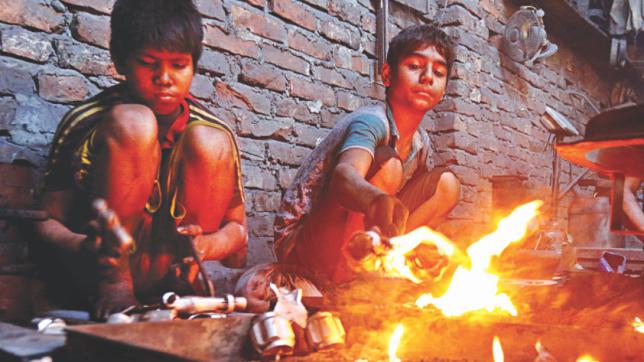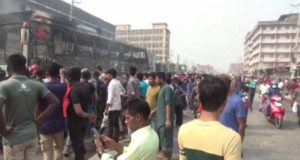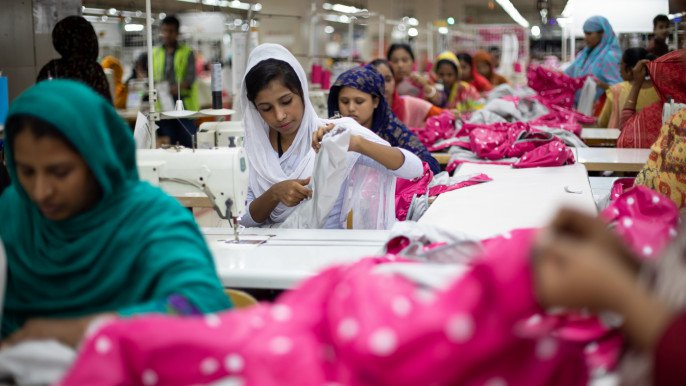Published in The Daily Star on November 20, 2017

Photo: Anisur Rahman/ The Daily Star
Alamgir jumped out of a human haulier inside Dhaka Cantonment and kept hollering at the top of his voice, “Jahangir Gate, Jahangir Gate”.
Within minutes, all the seats got filled up, the vehicle started moving and the 14-year-old boy began collecting fare standing on the step.
Rain or shine, Alamgir, who looked thinner than most children his age, has been assisting the driver for long hours every day for the last six months.
Asked why he has to toil this way, the boy, wearing brown trousers and a red T-shirt, twisted his lips into a faint smile, balancing his weight on the step.
“Is this hard work at all? I used to carry bricks and heavy bags of cement [before this job],” he said as he continued taking fare, counting money and returning the change to passengers.
Alamgir has been in hazardous jobs, as defined by the government in 2013, for the last two and a half years since his family moved to the capital from Sunamganj’s Dharmashala following a huge crop loss. He now lives near Matikata Bazar.
From his narrative, it seemed his struggle and financial troubles did not even let him think of education and fun time in school.
The government has made a number of policies, amended laws and signed ILO Convention 182 on worst forms of child labour to fight the menace. But, experts say, effective means should be created for such families that feel the supplementary income of their children is necessary for survival.
“The intergenerational transfer of poverty will continue if child labourers are not withdrawn from work,” said Prof ATM Nurul Amin, chairperson of Brac University’s Department of Economics and Social Sciences.
Child labour is a single issue that can hold the nation back from achieving a number of Sustainable Development Goals set for 2030, like universal secondary education and quality learning, poverty elimination, inclusive growth and human development, and decent work for all.
With hundreds of thousands of children engaged in hazardous work, it would not be possible to reach the goals.
The country has around 17 lakh child labourers and a majority of them — almost 13 lakh — is in hazardous work, shows the 2013 survey of the Bangladesh Bureau of Statistics.
The BBS/Unicef multiple indicator cluster survey 2006 points to a greater degree of child labour in slums — 19.1 percent, which is nearly 1.5 times that at the national level.
According to a survey by think-tank Overseas Development Institute on 2,700 slum households in Dhaka last year, the rate of child labour rises from around eight percent at the age of 10 to 45 percent at 14.
Poor education infrastructure and safety net coverage, high living cost in cities, the lure of making money, and the lack of awareness have been contributing to this high child labour rate, experts say.
As children tied to child labour grow older, the chances of them discontinuing their education rise. And the existing policies relating to compulsory education and child labour leave scope for that.
CHILDREN AGED 12-14 “LEGALLY NOWHERE”
According to Child Labour Act 2006, employing children aged below 14 “in any occupation or establishment” is illegal.
The act, however, has a provision that allows children aged between 12 and 14 to be engaged in “light work” for a maximum 42 hours a week. In case of school-going children, employers must arrange working hours in a way that allows them to attend school.
However, “light work” has not been defined and this leads to children of this group, especially those living in city slums, being taken advantage of. They are often employed in low-pay work in small, non-compliant factories and workshops and as domestic help.
Eight-year-old Sabina Akhter walks a few minutes to her workplace from home in Bhashantek slum in the capital. She returns from school, gulps down some food and then rushes to the house, where she is employed to mop the floor and do the dishes. Sabina works there seven days a week except for any emergency.
In a gathering at the shanty next to hers, the girl with curly hair blushed as others praised her for the wonderful work she does with her tiny hands.
Hard-pressed, her family cannot take care of her without her pitching in.
A vast majority of the children like Sabina work in informal sectors and that also makes enforcement of the act challenging, the Unicef says in a June 2010 report.
The latest child labour survey by the BBS in 2013 raised the same concern, as, unlike other indicators, child labour in informal sectors increased to 94.9 percent from 92.9 percent in 2002-2003.
After children finish the government’s compulsory education up to class-V at the age of around 10, many parents feel encouraged to put them into any kind of work that pays.
This happens more in city slums where the coverage of the social safety net programmes is scanty, adding to the concerns over children being abused at work.
Sabina’s mother Shirin Begum, 30, explained why it was good that her daughter spent nearly five hours a day at work. “Sabina comes back home [by 3:00pm] from work around the same time I return from work. … It is safer there [where Sabina is employed] … We hear news of many things happening to girls in slums.”
As she was trying to justify child labour, she talked about other issues that are intertwined with the cycle of illiteracy, child labour and poverty.
The overall national child labour situation seems improving, comparing the BBS 2002-03 report with that in 2013. The rate of child labourers of age 5-17 came down significantly from 7.5 percent to 4.3 percent.
Still, the number of child labourers is very high in the country and their highest concentration is in Dhaka, 0.69 million.
A National Human Rights Commission report suggested making a list of “light work” to protect children of 12-14 years, just like the government’s 2013 list of hazardous activities forbidden for those below 18.
The International Labour Organisation that commissioned the study recommends that “light work” should not exceed 14 hours a week and should not hamper a child’s education.
EDUCATION, SOCIAL SAFETY NET, AWARENESS
ILO’s Munira Sultana, who works on the country’s child labour issue, says the problem is deeply rooted in the society. Building awareness among those who are employing children is one of the best ways to address that.
Besides, the government is responsible for ensuring basic rights of all, including the slum population. With poor people’s concentration increasing in cities, efforts should be made to ensure greater access to education and safety net programmes.
The national education policy 2010 raises compulsory education from grade five to grade eight and compulsory education age from 10 to 14, which, experts say, should be implemented immediately, as it would help curb child labour.
The government has adopted National Social Security Strategy in 2015 sketching out a life-cycle approach to better address poverty, says Prof M Abu Eusuf, chairman of the development studies department at Dhaka University.
The urban poor would have better coverage of the safety net if the NSSS comes into effect, he added.
Shirin was one among those of her time who had been left behind and her daughter Sabina is teetering on the edge of a similar fate.
In her initial years of marriage, Shirin, from Shibla in Astagram upazila of Kishoreganj, was full of hope that with hers and her husband’s income, she would be able to ensure the wellbeing of their family.
The first child, Jesmin Akhter, 15, studied up to class-IV. But as the number of family members increased, her education cost was the first thing Shirin had to cut.
Studying in a public school is free, but there are associated costs like that of purchasing stationeries. Besides, children in crowded classrooms in such schools often feel discouraged from learning. Parents, with no or little education but having desire to give their children education, often go for private tuitions.
When Jesmin was in school, Shirin was young and capable of working harder, and she and her husband could bear her expenses. But with the family having to cover ever-rising expenses, Jesmin had to drop out of school and join a garment factory two years ago.
Jesmin’s 12-year-old brother Sagor, who works at a doctor’s chamber as an assistant, is on the verge of leaving school as well, as, Shirin said, he had been failing in exams for two consecutive years.
Interrupting Shirin, her neighbour Taslima Akhter, of Shariatpur in Kishoreganj, explained why her three children — two sons aged 10 and 14 and a daughter of eight — were not studying anymore. She and her husband came back to Dhaka with the children only a month ago after suffering crop loss to floods that had caught them off guard in April.
Now the family is desperate for work.
Taslima said her children while studying in village public schools got financial support like stipends but in Dhaka they would not get those, making it even harder for the family to think about the children’s education.
And even if the family settles in, time and struggle may unfortunately get their focus away from education.
 CPD RMG Study Stitching a better future for Bangladesh
CPD RMG Study Stitching a better future for Bangladesh



